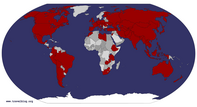Advertisement
Published: June 26th 2020
So, here is an interesting question. How many ways can you use coins to make a dollar, or 100 cents? I will give the answer below. I tried to do it by writing it down, but fell woefully short. Here is the formula: (From Galactus) This is a counting problem, not arithmetic.What coins can you use? If it's quarters, nickels, dimes, and pennies, then:The number of ways to get a sum of 100 by adding 25,10,5,1 is the coefficient of x100 in the expansion of:<br style="-webkit-font-smoothing: antialiased; color:𢡦 font-family: 'Segoe UI', 'Helvetica Neue', Helvetica, Roboto, Oxygen, Ubuntu, Cantarell, 'Fira Sans', 'Droid Sans', sans-serif; font-size:
15px; background-color: #fdfdfd;" />L(1+x25+x50+....)(1+x10+x20+x30+....)(1+x5+x10+x15+....)(1+x+x2+x3+x4+...)=1(1−x25)(1−x10)(1−x5)(1−x)You will find the coefficient of x100 is 242.Using quarters, dimes, nickels and pennies there are 242 ways to make change for a dollar. It's 293 if you also use half-dollars.Using more than one type of coin, what is the least number of coins you can use to make a dollar?Answer: Six coins: 3 quarters, 2 dimes, one nickel = a dollarHere is another coin problem
for you to solve:There is a collection of nickels, dimes, and quarters with total value of $47.60.There are 28 more dimes than nickels. There are 5 times as many quarters as dimes.How many quarters are in the collection? Answer below.Then your dear Uncle shows up: Your uncle walks in, jingling the coins in his pocket. He grins at you and tells you that you can have all the coins if you can figure out how many of each kind of coin he is carrying. You're not too interested until he tells you that he's been collecting those gold-tone one-dollar coins. The twenty-six coins in his pocket are all dollars and quarters, and they add up to seventeen dollars in value. How many of each coin does he have? Answer below.
Gerry
Solution 1 Let "d" be the number of dimes.Then the number of quarters is 5d,and the number of nickels is d-28, according to the condition.Hence, the total in cents is10d + 25*(5d) + 5*(d-28) = 4760, or10d + 125d + 5d - 140 = 4760, or140d = 4760 + 140,d =
140)
= 35.So, there are 35 dimes in the collection.Then the number of quarters is 5*35 = 175 and the number of nickels is 35 - 28 = 7.Check. 5*7 + 10*35 + 25*175 = 4760. Correct !Answer. 7 nickels, 35 dimes and 175 quarters.
Uncle : To solve the Uncle puzzle, you need to use the total number of coins, the values of the two types of coines, and the total value of those coins.
There are twenty-six coins in total. Some of them are quarter coins; let "q" stand for the number of quarters. The rest of the coins are dollar coins. Since there are 26 coins in total and q of them are quarter coins, then there are 26 – q coins left to be dollar coins.
If your uncle has only one quarter, then 25×1 = 25 cents comes from quarters. If he has two quarters, then 25×2 = 50 cents comes from quarters. Since he has q quarters, then 25×q = 25q cents comes from quarters.
For the dollar coins, we need first to convert their value to cents; one dollar is one hundred cents. Since he has 26 – q dollars, then he has 100(26 – q) cents from the dollar coins.
He has seventeen dollars in total, or 1700 cents, part of which is from quarters and part of which is from dollars. To help keep things straight, we can set up a table:
numberof coinscentsper cointotalcentsquartersq2525qdollars
26 – q100100(26 – q)total26 1700
Advertisement
The total value comes from adding the value of the quarters and the value of the dollar coins. So we add the "total cents" expressions from the right-hand column above, and set this sum equal to the given total:
25q + 100(26 – q) = 1700
Then
solve:
25q + 100(26 – q) = 170025q + 2600 – 100q = 1700–75q + 2600 = 1700–75q = –900q = 12
In other words, 12 of the coins are quarters. Since the remainder of the twenty-six coins are dollar coins, then there are 26 – 12 = 14 dollar coins. I can check to make sure this works: 14×$1 + 12×$0.25 = $14 + $3 = $17. Since the answer works in the original exercise, it must be right.
So, when you are bored, just pull out some coins from your spare change box. It might lead to something interesting?
Advertisement
Tot: 0.121s; Tpl: 0.011s; cc: 15; qc: 27; dbt: 0.0738s; 1; m:domysql w:travelblog (10.17.0.13); sld: 1;
; mem: 1.1mb












